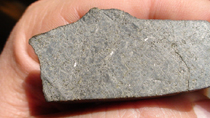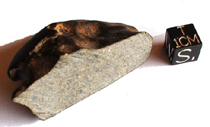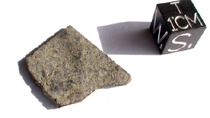Eucrites
The Eucrites are named for a Greek word meaning "easily
distinguished". Representing the most common class of achondrites,
more than 100 eucrites are known, excluding all probable pairings.
Although they are easily distinguished from chondrites, they closely
resemble terrestrial basalts. Actually, eucrites are extraterrestrial
basalts, volcanic rocks of magmatic origin, representing the crust of
their parent body, Vesta. They are primarily composed of the calcium-poor
pyroxene, pigeonite, and the calcium-rich plagioclase, anorthite.
Additionally, eucrites often contain accessory minerals such as silica,
chromite, troilite, and nickel-iron metal. Based on mineralogical and
chemical differences, the eucrites have been further divided into three
distinct subgroups: the non-cumulate group, the cumulate
group, and the polymict group.
|
Northwest
Africa 1240
Northwest Africa
Found 2001
Achondrite (????)
A single stone of 98 g was found in Morocco
|

|
 
|
|
|
|
NWA 1240-00
51.10 gr
Main mass of this rare type of achondrite, covered of fusion
crust !
Price
on request |
|
|
|
|
|
|
|
NWA 1240-01
1.90 gr
An extrordinary nice slice of this unique
achondrite. Huge
crystals and fusion crust !
price
on request
|
|
|
|
  |
|
|
|
|
|
|
|